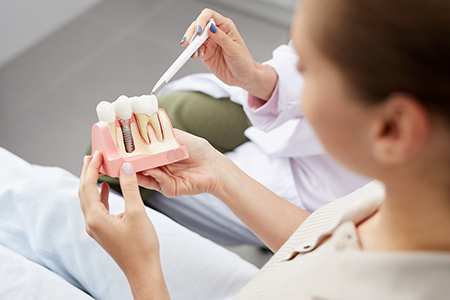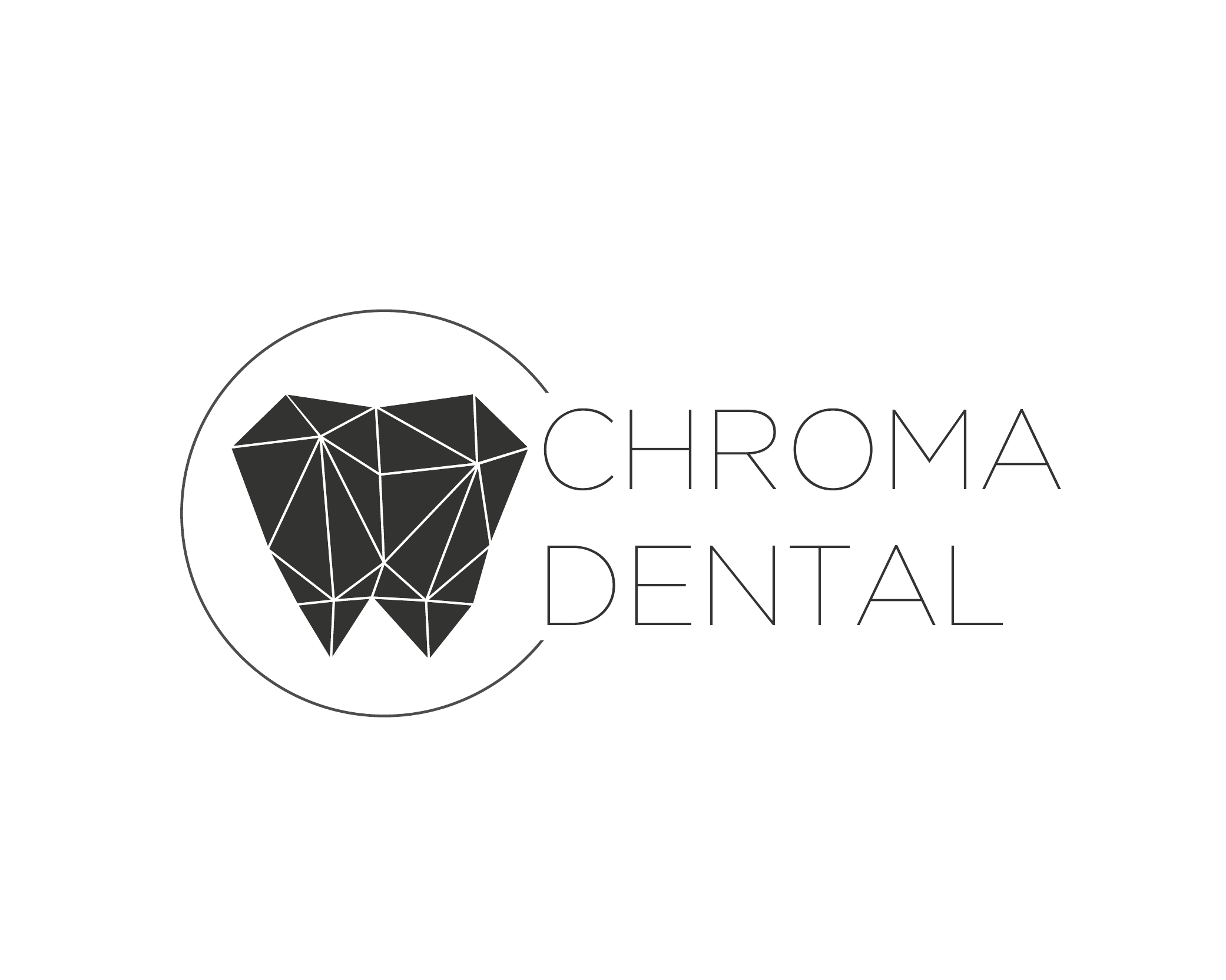Missing teeth change more than the way your smile looks — they alter how you eat, speak, and how your jaw ages over time. Whether tooth loss came from decay, periodontal disease, or an injury, contemporary implant dentistry offers predictable ways to restore function and confidence. Our goal is to help you understand the options so you can choose a path that fits your health goals and lifestyle.
Dental implants are now the industry standard for long-term tooth replacement because they recreate both the visible tooth and the supporting root structure beneath the gumline. That foundation is what allows implant-supported restorations to feel and perform more like natural teeth than removable alternatives. For patients who want stability, durability, and a natural appearance, implant therapy is a powerful solution.
At Chroma Dental, we approach implant care with careful planning and attention to detail to deliver results that look natural and last. We’ll evaluate your overall oral health, discuss the prosthetic goals you have in mind, and explain how implant options can address both immediate needs and long-term oral wellness.

Unlike conventional bridges or removable dentures, implants are anchored into the jaw and replace the root as well as the crown. This anchorage provides exceptional stability for chewing, speaking, and maintaining facial structure. Patients frequently remark that well-designed implant restorations restore a sense of normalcy that removable options cannot match.
Because implants integrate with the jawbone, they help preserve the bone volume that otherwise diminishes after tooth loss. That preservation has aesthetic as well as functional benefits — supporting the overlying soft tissues and helping maintain the contours of the face. Over time, this can make a significant difference in how the mouth and lower face appear.
Implant restorations are versatile: a single crown can replace a single tooth, multiple implants can support a bridge, and strategic implant placement can stabilize or retain a denture. This flexibility allows treatments to be customized for comfort, function, and appearance, while minimizing impact to the surrounding natural teeth.
At their core, dental implants are biocompatible posts — typically titanium or a titanium alloy — designed to serve as artificial tooth roots. Once placed into the jaw, the surrounding bone grows closely against the implant in a process called osseointegration, creating a strong and stable foundation for a replacement tooth.
After osseointegration, a prosthetic component such as a crown, bridge, or overdenture is attached to the implant. Modern implant systems offer a range of abutments and restorative materials so clinicians can match shade, shape, and bite for a result that blends seamlessly with your remaining teeth.
Long-term success depends on precise surgical placement, thoughtful prosthetic design, and regular maintenance. With proper planning and oral hygiene, implants provide durable function and predictable aesthetics for many years.
Implants deliver advantages that extend beyond appearance. They restore the ability to bite and chew a wide variety of foods, which supports better nutrition and enjoyment of meals. Their stability eliminates common concerns with removable prostheses, like shifting or clicking during conversation.
Because implants stimulate the jawbone, they reduce the bone loss that often follows tooth extraction. That stimulation helps maintain jaw height and facial proportions, which can otherwise change and lead to a collapsed or prematurely aged appearance.
Implants are also designed to be low-maintenance: they do not decay, and with good oral hygiene and routine dental visits, many implant restorations remain fully functional for decades. Unlike bridges, implant-supported teeth typically do not require altering adjacent healthy teeth to provide support.

Candidacy for implants is based on a combination of medical history, oral health, bone volume, and individual goals. Many people who have lost teeth are suitable candidates; even patients with reduced bone can often be treated successfully with advanced techniques such as grafting or angled implant placement.
A careful diagnostic process — including a clinical exam, dental imaging, and discussion of medical factors — helps us design a safe, effective plan. We look at your bite, soft tissues, and aesthetic goals so the final result integrates with your existing smile and function.
If you’re curious about implant therapy, a consultation will clarify your options and outline the steps that would be involved in your individualized plan.
Implant treatment begins with a comprehensive evaluation and 3D imaging when needed to visualize bone anatomy and critical structures. Surgical guides and digital planning help determine precise implant positions for optimal support and aesthetics. This planning phase is essential to predictable outcomes.
Surgical placement of implants is generally an outpatient procedure performed under local anesthesia, with sedation options available for patient comfort. Depending on the clinical situation, the implant may receive a temporary restoration immediately or the site may be allowed to heal before the final prosthesis is attached.
After placement, a healing period allows the implant to integrate with the bone. Once integration is confirmed, the restorative phase begins — custom crowns, bridges, or dentures are fabricated to match your bite and smile. Follow-up care focuses on hygiene, monitoring, and routine maintenance to protect the investment in your oral health.

Bone grafting is a common adjunctive procedure when the jaw lacks sufficient volume or density to support an implant. Grafting rebuilds the ridge and creates a stable foundation for implant placement. Material choices and timing depend on the individual's anatomy and the overall treatment strategy.
Performing a graft before or during implant placement can increase long-term success and improve the aesthetic outcome by providing better soft-tissue support. Our approach emphasizes minimally invasive techniques and evidence-based materials to achieve predictable results.
Replacing missing teeth with implants can restore comfort, function, and confidence while preserving the health of your jaw and remaining teeth. Whether you are considering a single tooth replacement or a full-arch restoration, careful planning and skilled execution are the keys to a successful outcome.
If you’d like to learn more about implant options and what might be appropriate for your situation, contact us for more information and to schedule a consultation. Our team can answer your questions and help you take the first step toward a stable, lasting smile.
If you've lost a tooth due to injury, decay, gum disease, or any other reason, we recommend dental implants to replace missing teeth. Dental implants come the closest to replicating the look, feel, and function of your natural teeth.
Dental implants are placed into the jawbone and mirror the same function as the root of a tooth. The procedure for dental implants is usually performed while a patient is sedated. Patients who undergo IV sedation must have an empty stomach and transportation home following the procedure. Most sedation patients will have little to no memory of the procedure occurring.
Generally, dental implants are made out of a biocompatible metal such as titanium. Biocompatible metals are also used for other common bone implants (such as shoulder, hip, and knee replacements). The visible portion of the implant is usually made out of porcelain and is custom-made to match your existing teeth.
Dental implants are designed to fuse to the bone, which makes them become permanent fixtures. Typically speaking, the success rate is nearly 100%. There are few cases in which the implant will not fuse as intended and must be removed. If this happens to occur, the procedure can be attempted again a few months later.
Dental implants are not usually covered by dental insurance, but may be covered under a patient's medical insurance. Our office and your insurance company can discuss coverage options with you based on your individual case and treatment plan.
It's easy... just take care of an implant as if it's a natural tooth! This involves regular brushing, flossing, and dental checkups. If you have any concerns about your implant, contact us immediately.
